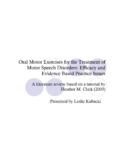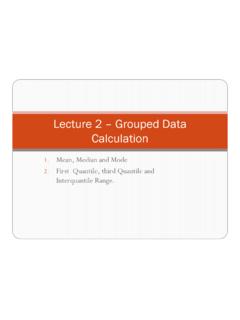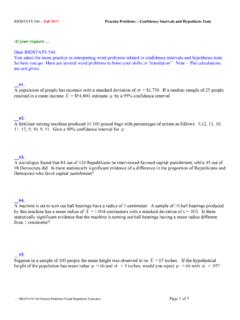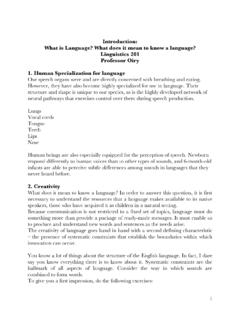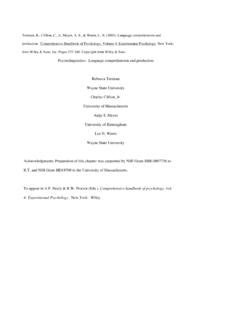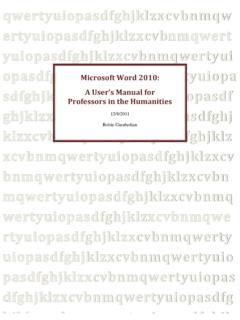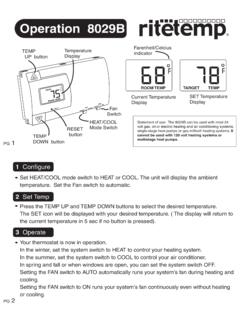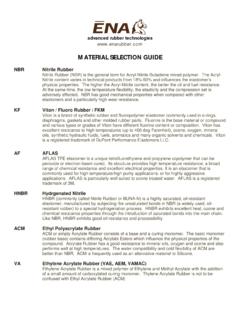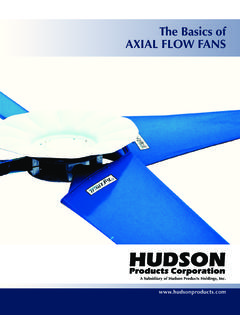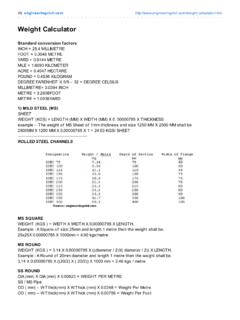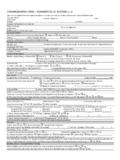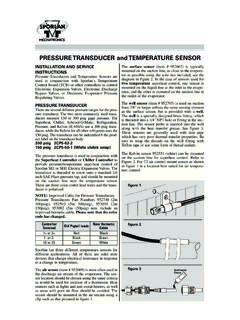Transcription of Potential energy - UMass
1 Physics 190E: energy & SocietyFall 2007 Physics of energy II - 1 Now, let s talk about a second form of energyPotential energyImagine you are standing on top of half dome inYosemite valley, holding a rock in your rock has no kinetic energy , but if you threwit off the cliff it would have quite a bit of kineticenergy by the time it hit the valley say that the rock has Potential energy . If mis the mass of the rock and h the height aboveground, the Potential energy of the rock is g here?Let s pick up where we left off last topic was gravitational potentialenergyPhysics 190E: energy & SocietyFall 2007 Physics of energy II - 2 Reading assignment intextbook - chapter 3 - work, energy & powerRecall also the reading 190E: energy & SocietyFall 2007 Physics of energy II - 3g is known as the gravitational constant. It measures the strength ofthe Earth s gravitational pull on falling demonstrated that all objects fall the same two objects are dropped from the same height at thesame time, then they will hit the ground at the same time(as long as other forces like air resistance are negligible).
2 Falling objects accelerate downwards at a rate of ..g= is the rate of change of velocity with , the units of acceleration are the units for velocitydivided by another factor of 190E: energy & SocietyFall 2007 Physics of energy II - 4 More on acceleration & related Ferrari F430 Weight: 3196 lb (1450 kg)Fuel Economy city/highway 11/16 mpgAcceleration: 0-62 mph in Speed:>196 mph (>315 km/h)Let s calculate its acceleration in meters/(second)22007 Toyota Prius0-60 mph in 10s60mpg(city), 50mpg(hway)Physics 190E: energy & SocietyFall 2007 Physics of energy II - 5 Basic physics result - if an object starts at rest at time t=0 and accelerates with aconstant acceleration, its velocity increases linearly with v=a!taccelerationIf we want to figure out the acceleration, we can rewrite this as a=v/tThe car accelerates, reaching a velocity of v=62 mph = 28 m/s in t=4 s,which gives a=(28ms!1)/(4s)=7ms!2A little bit smaller than thegravitational acceleration ofg= 190E: energy & SocietyFall 2007 Physics of energy II - 6 While we re talking about acceleration, let s introduce another pieceof basic physics.
3 Newton s 2nd law. F=m!aForce equals mass times acceleration. If there is a netforce on an object, it will accelerate. Conversely, ifsomething is accelerating, there must be a force on to gravitational force (at theearth s surface) is F=m!gSetting these two expressions equal, we see that the mass cancels giving a=gindependent of the mass of the is your weight. The forcethat a scale pushes up on your feetwith to counterbalance 190E: energy & SocietyFall 2007 Physics of energy II - 7 The fact that the masses are the same in thesetwo equations has very deep significance inphysics. This equivalence principle ledEinstein to his theory of gravity - generalrelativity - in which the gravitational force is amanifestation of the curvature of mass in Newton s 2nd law (F=ma) isknown as the inertial mass, while the massin the gravitational force law (F=mg) isknown as the gravitational equivalence principle has been demonstratedexperimentally to one part in a 190E: energy & SocietyFall 2007 Physics of energy II - 8We can check that Potential energy indeed has the units of PE=mghIf the mass is measured in kilograms and the height in metersthen the units of Potential energy work out to kg!
4 (ms"2)!m=kg!m2!s"2=JoulesFinally, back to gravitational Potential energyRecall these units came out naturally fromthe formula for Kinetic energy 1/2 mv2 Physics 190E: energy & SocietyFall 2007 Physics of energy II - 9We can also check that falling objects satisfy conservation of we drop something from a height D at time t=0, then it s position andvelocities as functions of time are given by h(t)=D!12gt2 v(t)=!gtNow, let s calculate the total energy as a function of time. E=KE+PE=12mv(t)2+mgh(t) E=12(!gt)2+mg(D!12gt2)=mgDThe result is actually independent of time and equal to the initial Potential energy ,demonstrating conservation of 190E: energy & SocietyFall 2007 Physics of energy II - 10A practical application of gravitational Potential energy .. How to storeenergy without a battery?We ll see that one problem with electricity is that it s difficult tostore. Batteries are only practical for relatively small amounts ofenergy. How do you store more massive quantities?
5 One wayis to use it to lift up water and convert the electrical energy togravitational Potential energy . This is called pumped Northfield Mountain pumped storage hydroelectric plant - operated by FirstLight Power Resources - is located in Northfield, MA about 20 minutes north ofcampus (up route 63).Physics 190E: energy & SocietyFall 2007 Physics of energy II - 11 Info from 1080 MegaWatt plant atNorthfield Mountain facilityopened in 1972 and was thelargest in the world at that periods of low demand,water is pumped miles fromthe Connecticut river to a 300acre reservoir, 800 feet above theriver, which holds billiongallons of generating mode, water flowsdownhill through 4 turbinegenerators at a rate of 20,000gallons per paper topicPhysics 190E: energy & SocietyFall 2007 Physics of energy II - 12So far, we ve talked about two forms of energy - kinetic energyand gravitational Potential energy . Now, we ll introduce a 3rd -thermal energy .
6 We will try to understand what it means forsomething to be hot and how much energy it takes to heatsomething up? We ll see that for a gas, like the air in this room,thermal energy is just the sum of the kinetic energies of theindividual gas the mechanical equivalenceof heat - that mechanical energy could betransformed into heat and vice-versa - was amajor achievement of 19th century EnergyThis effort was closely tied to the industrialrevolution and the need to understand howthings like steam engines (which convert heatinto mechanical energy ) work ..Read Chapter 7 Physics 190E: energy & SocietyFall 2007 Physics of energy II - 13A good way to start into this subject is to talkabout the amount of energy it takes to heatsomething up?One way to talk about this is just to give it a name ..The British Thermal Unit (or BTU) is defined as1 BTU = amount of energy required to raise thetemperature of 1 pound of water by 1 already have another unit of energy - theJoule.
7 We need to know how many Joulesdoes a BTU correspond to? This is a questionfor experimentalists?Frigidaire 6000 BTU Air ConditionerReally this means BTU/hour - ameasure of the cooling capacity of theair conditionerPhysics 190E: energy & SocietyFall 2007 Physics of energy II - 14 James Joule, 1818-1889Of course, at the time the mechanical unit of energy in use wasnot the was the foot-pound. Before coming back to Joule s work,let s take yet another detour into units and talk about the foot-pound as a measure of This will allow us to bring upanother important point about was a question that interested James Joule, 190E: energy & SocietyFall 2007 Physics of energy II - 15 The usual definition of energy given in introductory physics textbooksis .. energy = capacity to do workOf course, to complete the definition we need to ask what physicistsmean by work?If you sit in the library reading a book for acourse, are you doing work in the physicssense?
8 NoIn physics work means very specifically exerting a force through a distance, withthe direction of motion in the same direction as the 190E: energy & SocietyFall 2007 Physics of energy II - 16 This part about directions is important ..An elevator does work when it takes us betweenfloors, because the force it exerts is in the samedirection as its motion - , if someone is walking along carryingsomething, they are not doing any work (at least onthe object they are carrying) in the physics sense -there is no force in the direction of motion. Theforce is upwards, while the direction of motion makes sense because in the first case, the elevator goes up and the work it doesincreases the Potential energy of itself and whoever is inside. However, in carryingwater, the water is always staying at the same 190E: energy & SocietyFall 2007 Physics of energy II - 17So long as the force and motion are in the same direction, the formulafor work isW = (Force)(Distance) = F DThe foot-pound combines a unit of force - a pound -with a unit ofdistance - a foot - and is thereby a unit of work or energy .
9 1 foot-poundis the amount of work that must be done to raise a 1 pound weight by 1foot. This also gives the change in Potential energy of the 1 : Pounds are used both as a measure of force and of mass, whichcan be confusing. A pound-mass is the amount of mass that weighs 1pound on the surface of the Earth. However, on the surface of the moonit would weigh something less than a When we make aconversion 1 pound = kilograms, we are really talking about 190E: energy & SocietyFall 2007 Physics of energy II - 18 Yet another SI unit for force is called the (kilogram)(meter)/(second)2 This makes sense, based on the equation F=m!aThe unit of force is the unit of mass times the unit of s check that work has the same dimensions as energy . Work equals forcetimes distance. So a unit of work is a Newton-meter = 1 (kg m s-2) m = 1 kg m2/s2=1 JoulePhysics 190E: energy & SocietyFall 2007 Physics of energy II - 19 Back to Joule and the mechanicalequivalent of heatJoule built an apparatus in whichwater was heated by mechanicalagitation.
10 He could measure boththe temperature change in thewater and the amount of workdone by the that 1 BTU is the amount of energy needed to raise the temperatureof a pound of water by 1 degree farenheit. Joule found that1 BTU = 773 modern measurement is 1 BTU = foot pounds. So Joule smeasurement was quite 190E: energy & SocietyFall 2007 Physics of energy II - 20 Let s focus on this relation between heat and mechanical workWe see that this same amount of energy with lift a 1 pound weight nearly 800 feetin the air, or equivalently a 100 pound weight up to a height of 8 , the fact that burning fossil fuels yields quiteuseful amounts of mechanical energy is what made theindustrial revolution We ll return to thisin much more detail BTU = foot-poundsand note that 1 BTU is approximately the amount of energyreleased by burning a match. Burning releases the storedchemical energy in the is quite remarkable that the chemical energy stored insuch a small piece of material could accomplish such a feat!
